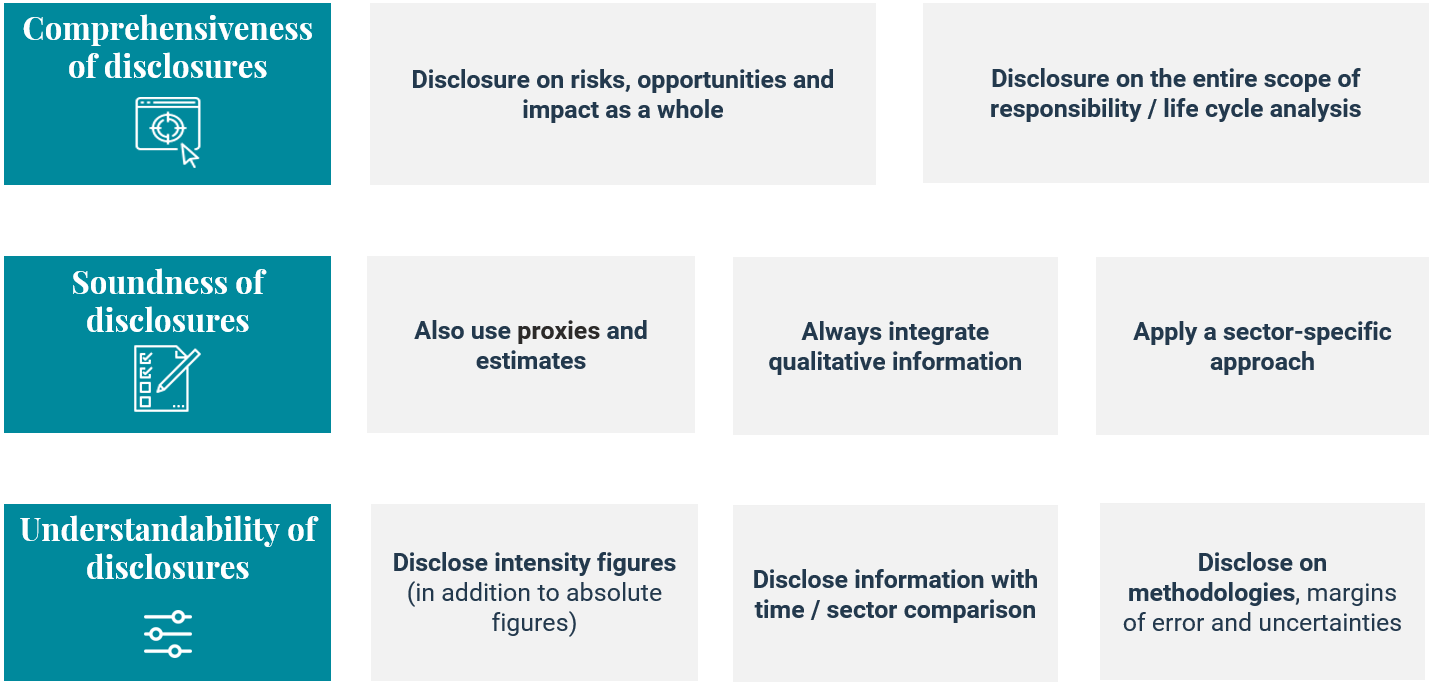Corporate sustainability disclosure: keep it simple, make it useful
As sustainable investment is confirmed both as a crucial need and a growing trend, climate and ESG1 corporate disclosures remain on top of regulators and investors’ agenda. The European Union (EU) is currently revising its requirements for corporates sustainability disclosure (Corporate Sustainability Reporting Directive or CSRD). International bodies, the International Financial Reporting Standards (IFRS) and International Organization of Securities Commissions (IOSCO), are aiming for a climate disclosure “building block” to align practices at the global level. In June, the US Securities and Exchanges Commission (SEC) finalized a public consultation on corporate climate disclosures, to which Mirova responded. We share below our views that we have conveyed to the SEC and across various jurisdictions and initiatives (the EU, TCFD2…) in order to build robust, meaningful and useful frameworks for corporate climate and sustainability disclosure.
Corporate climate disclosures: as an investor, what do we expect
As an investor fully dedicated to sustainability, and now also a B-Corp* and a mission-driven company**, we are striving to obtain information that enables us to understand a company’s exposure to and impact on sustainability and climate change holistically. We need comprehensive but also concrete information, expertise and analysis to support our investment decision-making.
As a result, we expect selective disclosure that is limited to a few key-indicators, completed with qualitative information only to the extent it is indispensable to understand the data; we are not in favor of long disclosures that often have limited added value for investors and represent a significant burden for issuers.
What we won’t get and why it doesn’t matter
Sustainability data in general, and climate data specifically is often criticized for being too complex to be appropriately calculated and disclosed. For example, at this stage, investors largely rely on proxies and estimates, as is the case for indicators such as Scope 3 GHG3 emissions. Methodologies are still improving and standards are emerging. Disclosure of comparable GHG emissions information will take time and will not be perfect. Arguing that sustainability information cannot be disclosed with the same level of accuracy as financial data, many stakeholders have advocated to limit the scope and ambition of sustainability and disclosure requirements.
We believe the opposite to be the only possible way forward. First, we cannot afford to wait for the perfect information to assess the sustainability and climate impacts of a company. Second, in most cases, we do not feel we need an extremely high level of accuracy to use sustainable and climate data in our investment decisions: as long as these disclosures enable us to answer the right questions (what are the risks and opportunities) on the right scope (entire life-cycle of a business), orders of magnitude are sufficient.
Data accuracy is important, but less crucial in our experience than to respect a certain number of disclosure principles aimed at providing investors with meaningful corporate sustainability information.
Our investor recommendation: keep it simple, make it useful

Comprehensiveness of disclosures
Climate and sustainability disclosure should enable investors to evaluate the whole impact of a company on climate, in order to make informed investment decisions.
a. Risks, opportunities and impact as a whole
We believe the level of risks and opportunities can be determined mainly through the share of activity that is exposed to green/climate-environmentally sustainable activities and the share of activities that is exposed to brown/unsustainable activities, in addition to potentially neutral activities. This information could be tracked using financial metrics such as revenues. Investments (capital expenditures and operating expenses), profit and loss accounts indicators, Research and Development expenses should also be considered. Providing a forward-looking perspective is also a crucial element for investors. In this regard, it is of particular importance that an issuer can demonstrate how its entire business model can contribute to reaching certain defined sustainability objectives (for example, the Paris agreement and/or its own climate/sustainability-related objectives such as Net-Zero commitments).
b. Take into account the entire scope of responsibility and life cycle
Issuers’ impact on climate and sustainability-related issues are not limited to the operations they directly manage. Disclosures that are limited to an issuer’s direct operations would not prove sufficient to investors to comprehend the level of climate-related risks and opportunities associated with a business model. Indeed, reporting of all Scope 3 GHG emissions allows investors to assess the full impact of a company’s products and services along the value chain. As importantly, investors need access to information related to avoided GHG emissions resulting from the company’s business model and activities (sometimes called negative emissions). The limitation of climate disclosure to a company’s direct operations impairs the investor’s ability to evaluate the impact of the climate related risks and opportunities on the company’s future operating performance.
These disclosure objectives are not easy to reach but focusing on a few key indicators that can be easily computed by corporate issuers is the right approach.
Soundness of disclosures
Information requests to issuers should be adapted to the complexity of climate and sustainability-related considerations, so as to obtain meaningful information.
a. Also use proxies and estimates
In our experience, it is better to have estimated data on the entire value chain than information that is precise, but on a limited scope. Where an indicator is relevant but unperfect (like scope 3 emissions and avoided emissions), estimates should be used. Where no data or indicator exists, using proxies is a necessity as it is the only way to provide workable information. For example, in addition to GHG emissions data, exposure indicators are interesting proxies for investors to assess the level of exposure to certain sustainability issues (positive or negative) through the share of revenues derived from certain activities, such as fossil fuels. Issuers’ controversies review (external stakeholders reporting of controversial practices on issuers’ sustainability practices) is also a good proxy on exposure to climate/ESG-related risks.
b. Always integrate qualitative information
Quantitative indicators are important but, used alone, are not sufficient to describe the complexity of a company on sustainability issues. Qualitative information describing a company’s approach to climate change and sustainability issues, how it governs itself to tackle material sustainability exposures and risks, how it identifies, pilots and manages its climate impact: this type of information is in all cases indispensable.
c. Apply a sector-specific approach
Given the complexity of sustainability-related issues, we do not expect that data provided by different issuers will be directly comparable for many years, although this should remain regulators’ objective. Full transparency on methodologies and estimates of potential margins of variation are therefore indispensable for investors and data analysts to gauge the quality of the disclosed data and provide a safe harbor to data/information users.
All businesses do not have the same level of impact on climate change and associated risks and opportunities for investors. However, climate change is a cross-cutting issue that is becoming so crucial for our economies that we need to understand the positioning of all businesses and a common basis of disclosures for all sectors (as per our proposal below). In this regard, qualitative sector-specific information is crucial. For instance, assessing two high climate-stakes sectors such as energy and agriculture necessitates distinct approaches:
- *For the energy sector: information on the energy mix and the impact of combustion associated with each type of fuel
- For agriculture: information on changes in land use, utilisation of chemical inputs (fertilizers, pesticides), type of farming, etc.
Understandability of disclosures
Sustainability disclosures and climate-related information can be displayed in many ways that will not provide useful or sufficient information for investors.
a. Disclose intensity figures
Absolute figures are indispensable. However, most of the time, disclosure of sustainability/ESG-related information in absolute figures does not provide meaningful information for investors. On climate-information for instance, absolute figures of GHG emissions are most of the time difficult to interpret if they are not contextualized. We recommend presenting them through ratios. For instance, the level of emissions can be put in perspective per activity branch, or with respect to certain financial indicators or productivity indicators (teqCO2, teqCO2/revenue, teqCO2/kWh, teqCO2/production unit etc.).
b. Disclose information with time / sector comparison
It is often clearer when the impact of an issuer is presented with historical trends (3 years look-back period is a minimum; 5 to 10 years is ideal). A comparison to a sector average – that can be provided by brokers, data providers research analysts, also help evaluate an issuer’s specific situation in the context of its sector(s) of activity. This information (data, figures, qualitative information) should be disclosed on the basis of the same methodologies used by the issuer to ensure consistency.
c. Transparency on methodologies, margins of error and uncertainties
Given the complexity of sustainability-related issues, we do not expect that data provided by different issuers will be directly comparable for many years, although this should remain regulators’ objective. Full transparency on methodologies and estimates of potential margins of variation are therefore indispensable for investors and data analysts to gauge the quality of the disclosed data and provide a safe harbor to data/information users.
Our recommendations are based on the pragmatic feedback of an investor dedicated to sustainability. Sustainability and climate disclosures should never become a compliance exercise. We hope that the increasing normative competition to organise these new reporting frameworks will be led by the only priority that we should not lose sight of: the need to reconcile the search for financial performance with the financing of a sustainable transition and its associated environmental and social benefits.
1 - Environmental, Social and Governance
2 - Task Force on Climate-related Financial Disclosures
3 - Green House Gas
* References to a ranking, prize or label do not anticipate the future results of the latter, or of the fund, or of the manager.
Since 2006, the B Corp movement has been promoting strong values of change throughout the world to make businesses “a force for good” and to distinguish those which reconcile profit (for profit) and collective interest (for purpose). B Corp’s goal is to certify companies that integrate social, societal and environmental objectives into their business model and operations. More details here
** Introduced in France in 2018 under the Pacte Law, a ‘société à mission’ company must define its "raison d'être" and one or more social, societal or environmental objectives beyond profit. The purpose, and objectives aligned with this purpose, must be set out in its Articles of Association. The Articles specify the means by which the execution of the Mission will be monitored by a Mission Committee (a corporate body distinct from the board of directors which is responsible for monitoring the implementation of the mission with at least one employee.) An independent third party then verifies the execution of the Mission, via a written opinion which is annexed to the report of the Mission Committee to shareholders and made available on the website of the company for a period of five years.

The Article 173 of the French Law on energy and transition for Green Growth requires French investors to communicate how environmental, social, and governance issues are considered in their investment choices and processes. Going beyond compliance, the annual publication of our impact report is an opportunity for us to demonstrate why and how we have put sustainable development at the core of our investment policies and engagements. It is an opportunity for us to emphasize the way we create environmental and social value, while simultaneously realizing financial performance. We hope that this report strengthens the understanding and confidence in the quality of our approach as a responsible investor.

Understanding the markets, Investing, Engaging in dialogues, Measuring Impact... Read the new issue of Mirovα: Creating Sustainable Value

The gradual reduction of public support measures is ushering renewable energies into a new era: that of autonomy on electricity trading markets. The way in which the associated risks are managed (volatility, cannibalisation effects, modification of the supply/demand equilibrium, buyer consideration, etc.) therefore becomes a fundamental issue in the project’s business plan and consequently for all stakeholders. In this article, Mirova offers a look at merchant risk, how it can be analysed, the strategies to guard against it and the opportunities that can be seized.

